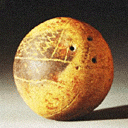Dom Pedro II
Modder For Life
The Age of Man Travel Guide
This introduction and brain-storming thread, I hope will one day be a tutorial thread for this mod.
In addition to adding a new dimension in warfare with numerous new units, this mod also intends to create much wider differences in the civilizations. This mod is really a celebration of the diversity of the human race. The name itself The Age of Man has been chosen because while something like Fate of Empires or Blood & Iron might sound cooler, they don't really encompass what we are. They are merely one aspect of who we are that often gets far more attention than it should, and the idea behind this is to grasp entirely the human experience. Indeed, this mod not only includes most of the aspects of everyone, but delves into the specifics of separate cultures.
Each civilization already has two distinct traits in the base game for Civilization. In The Age of Man, some of these traits are rearranged from vanilla Civ 3 for historical accuracy, and overall, the traits are honed and refined for each civilization creating greater strengths and more crippling weaknesses. It also makes for a completely different playing experience with each civilization.
The Americans and the Mongolians, for example, have fast settlers with defensive values that enable them to spread rapidly across a continent. However, they have lacking infrastructure in their early years due to Mongolian nomadic life and American self-sufficiency. So it's harder for them to hold their possessions earlier in the game, which makes them balance out with slower-expanding civilizations. Similarly, the Vikings and the Polynesians can expand much faster on a largely ocean-covered map with faster ships but are left high and dry on a map with little water. On ocean maps, the Vikings are also the best at combined arms in the Middle Ages with a powerful naval ship and powerful amphibious landing force.
The Aztecs have a powerful war-based society, but are deficient in terms of technology and peaceful expansion, and overall, they lack any single units that are vastly superior than their contemporaries. The Koreans, by comparison, have great educational facilities but are militarily weaker.
Each civilization has been placed into a cultural group, but not necessarily the same ones that are supported by the game. There are three religions that span more than one civilization though each civilization has a religion. They are Christianity, Islam, and Buddhism. Within Christianity, there is Catholicism, Orthodox Christianity, and Protestantism. Christian civilizations have some technologies specific to Christians as do Muslim civilizations and Buddhist civilizations. These allow for things like Cathedrals, Mosques, and Buddhist Monasteries as well as many other religion-specific features.
Three of the American civilizations (the Inca, Aztecs, and Maya) can research Ritual Sacrifice, but only one, the Aztecs can bring this to its pinnacle with Mass Sacrifice and double the cultural effect of the bloody rite. The tech tree is basically composed of one technological line shared by all civilizations that include many of the scientific developments such as Gunpowder and Iron Working and thus all strategic resources are available to all civilizations. Then there are religious cultural trees that several civilizations can usually share unless they have no common religion with another civ, but then beyond that are civilization-specific trees. They tend to be most numerous in the Ancient and Middle Ages eras, but they do continue through the Modern era.
Some civilizations have specific citizens such as the Sapa-Inca (Inca)and the Druids (Celts). Some religions have their own citizens as well.
Some civilizations have civ-specific resources such as the Inca who have the bonus resource Terrace Farms which can be found on hills and provide large food stuffs.
There are also civilization-specific wonders such as the Hodenosaunee League (Iroquois) and the Rig Vedas (Indians) that require numerous resources and prerequisite buildings. There are also wonders which all nations in a given religion can compete to build such as The Statue of Buddha (Buddhism) and Michelangelo's Chapel (Christianity).
Another feature, for example is that some units cannot be built by normal means. For example, the European civilizations have a variety of manors and feudal institutions that supply a source of knight units. The Aztecs similarly require a Calmecac that supplies them with Jaguar Warriors.
The civilization-specific technologies do not stop where the civilizations ended, but we continue on and suppose what developments they might have made given their strengths and weaknesses. For example, the Inca have their own coding system called Quipu, which is researched in the ancient era, but this primitive system lends itself to later eras when they become capable of researching Data Machines that give them a technological edge over other nations.
Well, I've basically let out most of my secrets. My creativity is out in the open
 .
.I do need some help though with concept work, so I figured I'd go to the masters. I need help with a lot of things, mostly technologies which include cultural developments. Suggestions are welcome!














 Actually, I was.
Actually, I was.
